Unit 9 Lesson 49 Get Along with Others 课件(32张PPT)
文档属性
| 名称 | Unit 9 Lesson 49 Get Along with Others 课件(32张PPT) | 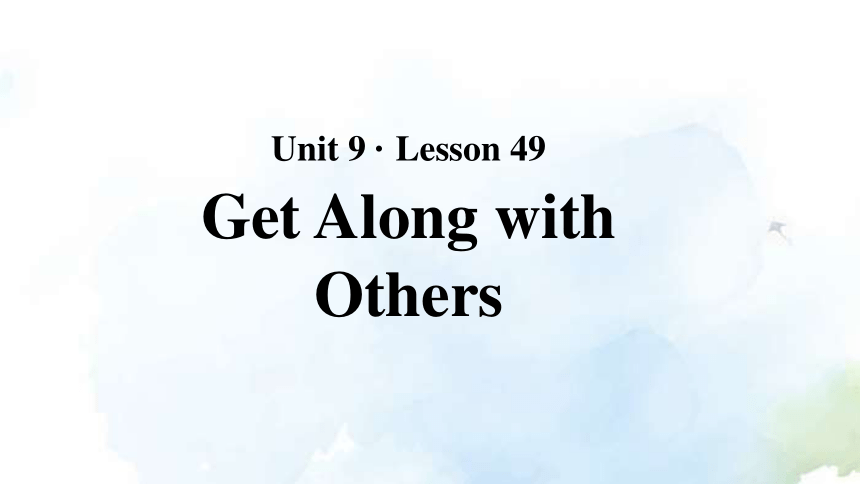 | |
| 格式 | pptx | ||
| 文件大小 | 1.1MB | ||
| 资源类型 | 教案 | ||
| 版本资源 | 冀教版 | ||
| 科目 | 英语 | ||
| 更新时间 | 2020-05-11 11:43:45 | ||
图片预览

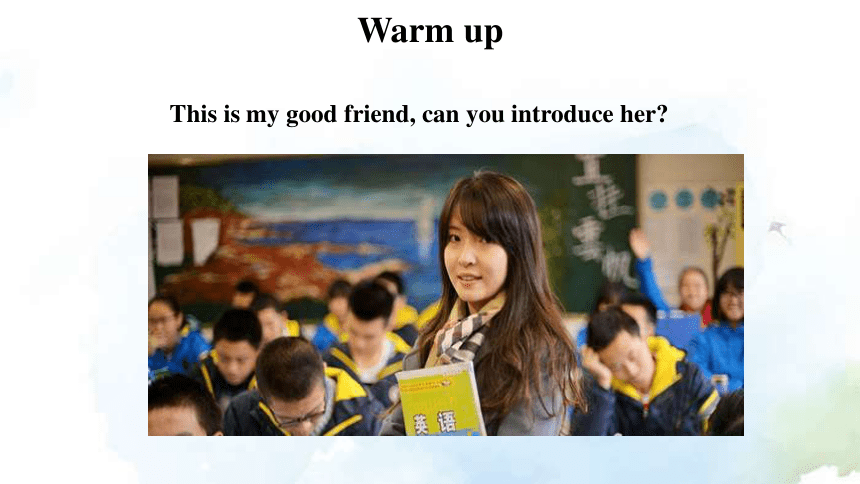
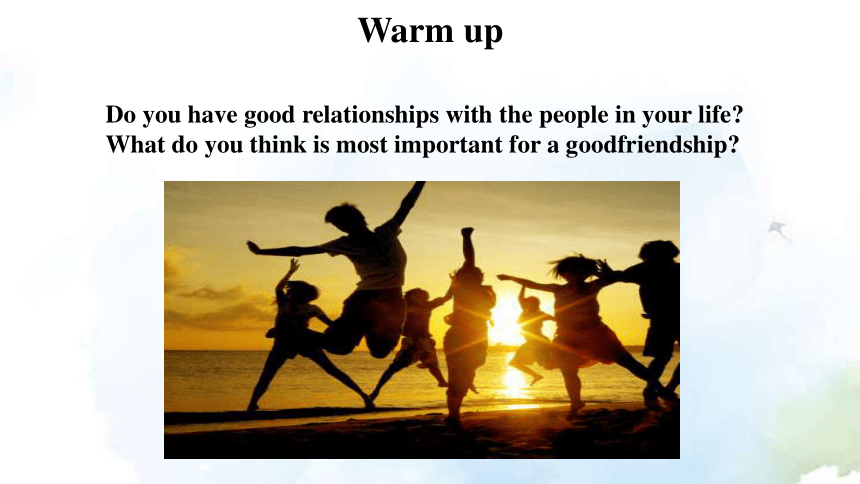

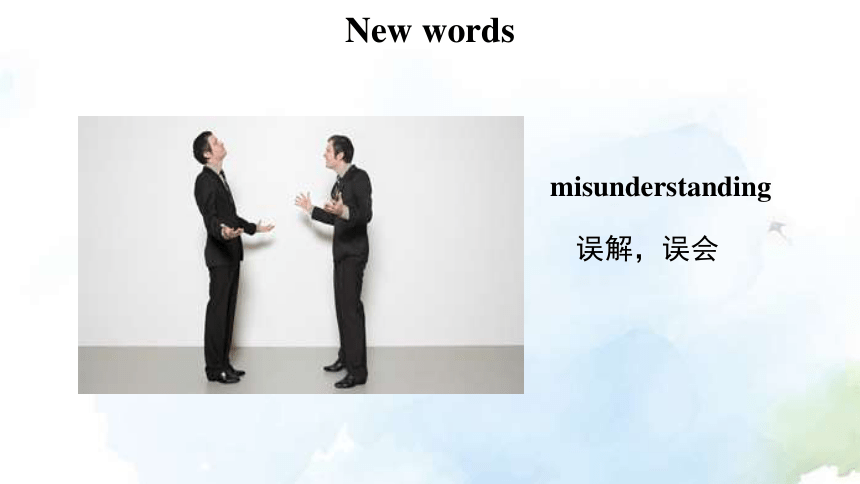




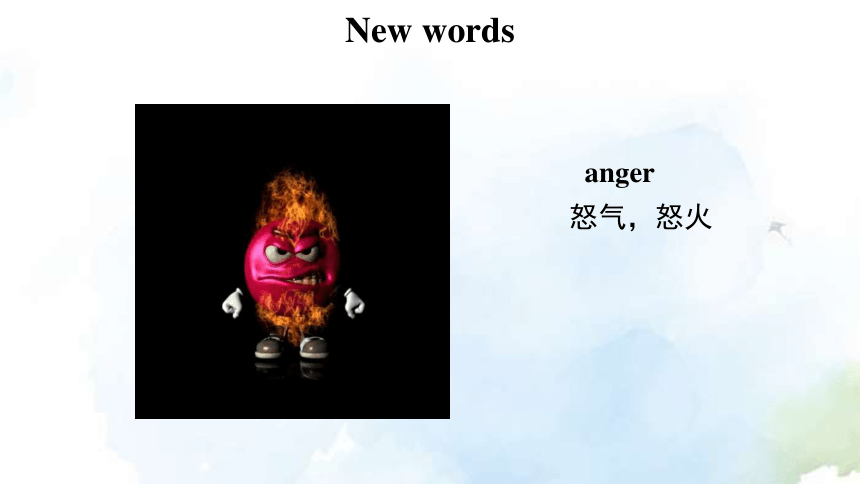


文档简介
(共32张PPT)
Unit 9 · Lesson 49
Get Along with Others
This is my good friend, can you introduce her
Warm up
Do you have good relationships with the people in your life
What do you think is most important for a goodfriendship
Warm up
unit
单元,单位
New words
misunderstanding
误解,误会
New words
require
需要,需求
New words
communication
交流,沟通
New words
hardly
几乎不
New words
解决办法
solution
New words
怒气,怒火
anger
New words
Read and match the people with their statements.
Friendship requires good communication.
People who know how to communicate well with others are more likely to succeed in their jobs.
It’s always better to get things out in the open.
Sometimes friends have misunderstandings.
Presentation
get along (with)“(与某人)和睦相处”。
e.g. Do you always get along well with your classmates
你总是跟同学们相处得很好吗?
require作及物动词,意为“需要;要求”,它的后面常接名词、代词、v.-ing形式、不定式的复合结构或that从句(从句谓语用“should + 动词原形”,其中should可以省略)。
e.g. These plants require lots of care and attention.
这些植物需要悉心照顾。
Language points
The pears require washing before eating.
梨吃前需要洗一下。
He requires that we (should) work all night.
他需要我们整晚都工作。
require doing sth.“需要(被)……”,=require to be done
e.g. The bike requires painting. = The house requires to be painted.
这辆自行车需要油漆一下。
require可用于被动语态,但不用于进行时态。
e.g. We are required to take part in the meeting.
我们需要参加这个会议。
Language points
It is / was the same with…(= So it is / was with…) 是表达“也”的一个句型,无论前提是肯定或否定意思都可使用。
— I didn’t talk much about communication
last night.
昨天晚上我没过多地谈论沟通问题。
— It was the same with me. So it was with
me. / I didn’t, either. / Neither did I.
我也是。
Language points
likely在本句中是形容词, 表示“可能的; 有倾向的”, 既可以用人作主语, 也可以用物作主语。
e.g. She isn’t likely to come now. It’s too late.
她很可能不会来了, 太晚了。
Language points
(1) get … out在此句中的意思是“使……出来”。
e.g. Please get the pig out.
请把那头猪放出来。
(2) in the open在此句中的意思是“公开
地”。
e.g. He doesn’t dare to act in the open.
他不敢公开行动。
Language points
in the open还有“在露天(户外、野外)”的意思。
e.g. Don’t sleep in the open.
别在户外睡觉。
come to在此句中的意思“得到 (结果)”。
e.g. They came to a fight.
结果他们打起来了。
move on在此处的意思是“更换话题”。
e.g. We have talked much about this trouble. Let’s move on.
对此我们谈得很多了, 更换话题吧。
Language points
hopefully是副词, 在句中作状语, 能这样用的通常是-ly结尾的副词。
e.g. Personally, I think he is a good teacher.
就我个人而言, 我认为他是个好老师。
Fortunately, she was not injured in the accident.
幸运的是, 事故中她没受伤。
Language points
Interestingly, the Italian man doesn’t speak his native language.
有趣的是, 这个意大利人不会说意大利语。
Satisfactorily, the leader sang high praise for our project.
满意的是, 领导高度评价我们的课题。
Language points
Rewrite the sentences below with the correct forms of the phrases from the lesson.
(1)It took them more than an hour to solve the problem.
→It took them more than an hour to____________________
(2)We had a wonderful time in the park.
→We had in the park.
come to a solution
a lot of fun
Practice
1. Using the search engines, you can _____find books in the library.
2. Here is a book on grammar.________, it will help you with your study.
Change the following adjectives into adverbs and
use them to complete the sentences.
easy________ hopeful _______ exact _______
real ________ serious ________
easily
hopefully
exactly
really
seriously
easily
Hopefully
Practice
3. The old lady walked _____ slowly. It took her a long time to get there.
4. I’m sorry to hear that. Was she _______ hurt
5. Jim must have copied Paul’s work because they made ________ the same mistakes.
really
seriously
exactly
Practice
Group work:
Practice the dialogue with your partners and act it out.
Practice
Work in groups.Share your ideas about communication.
You can use “I think…”,“I guess…”,“ That’s for sure!”, “That’s true!” or “ Good point!”.
Practice
Writing:
Think of a person you have known for a long time. Write about when you first met the person and what you often do together.
have a lot of fun together
have misunderstandings
get along with our friends
communicate well with others
be better to get things out in the open
Practice
Let’s do a quick quiz!
You know about Santa Claus, don’t you He’s that man in red clothes. He has a long, white beard. He wears black boots. He says, “Ho! Ho! Ho!” He and Christmas go together. Over the years, the stories about Santa Claus have grown.
He has an address, a special type of transportation and a special way to get into children’s houses. Do you know what they are Let’s do a quiz!
Practice
1. Where does Santa Claus live
It is said that Santa Claus lives at the North Pole.
2. Santa rides in a sleigh. What animals
pull his sleigh
Reindeer pull Santa’s sleigh.
Practice
3. Children believe that Santa visits them on Christmas Eve. How does he get into their houses
Santa comes down the chimney. When he leaves, he goes up the chimney.
Practice
Group work:
According to the two e-mails and make some changes in groups if you like.
Practice
Write about your experience that you received something as a gift you didn’t like.
1. Who gave you the gift
2. When did you get the gift
3. Why didn’t you like the gift
4. What was your reaction
Practice
1.Listen and read.
2.Finish exercises of this lesson.
Homework
再 见
Unit 9 · Lesson 49
Get Along with Others
This is my good friend, can you introduce her
Warm up
Do you have good relationships with the people in your life
What do you think is most important for a goodfriendship
Warm up
unit
单元,单位
New words
misunderstanding
误解,误会
New words
require
需要,需求
New words
communication
交流,沟通
New words
hardly
几乎不
New words
解决办法
solution
New words
怒气,怒火
anger
New words
Read and match the people with their statements.
Friendship requires good communication.
People who know how to communicate well with others are more likely to succeed in their jobs.
It’s always better to get things out in the open.
Sometimes friends have misunderstandings.
Presentation
get along (with)“(与某人)和睦相处”。
e.g. Do you always get along well with your classmates
你总是跟同学们相处得很好吗?
require作及物动词,意为“需要;要求”,它的后面常接名词、代词、v.-ing形式、不定式的复合结构或that从句(从句谓语用“should + 动词原形”,其中should可以省略)。
e.g. These plants require lots of care and attention.
这些植物需要悉心照顾。
Language points
The pears require washing before eating.
梨吃前需要洗一下。
He requires that we (should) work all night.
他需要我们整晚都工作。
require doing sth.“需要(被)……”,=require to be done
e.g. The bike requires painting. = The house requires to be painted.
这辆自行车需要油漆一下。
require可用于被动语态,但不用于进行时态。
e.g. We are required to take part in the meeting.
我们需要参加这个会议。
Language points
It is / was the same with…(= So it is / was with…) 是表达“也”的一个句型,无论前提是肯定或否定意思都可使用。
— I didn’t talk much about communication
last night.
昨天晚上我没过多地谈论沟通问题。
— It was the same with me. So it was with
me. / I didn’t, either. / Neither did I.
我也是。
Language points
likely在本句中是形容词, 表示“可能的; 有倾向的”, 既可以用人作主语, 也可以用物作主语。
e.g. She isn’t likely to come now. It’s too late.
她很可能不会来了, 太晚了。
Language points
(1) get … out在此句中的意思是“使……出来”。
e.g. Please get the pig out.
请把那头猪放出来。
(2) in the open在此句中的意思是“公开
地”。
e.g. He doesn’t dare to act in the open.
他不敢公开行动。
Language points
in the open还有“在露天(户外、野外)”的意思。
e.g. Don’t sleep in the open.
别在户外睡觉。
come to在此句中的意思“得到 (结果)”。
e.g. They came to a fight.
结果他们打起来了。
move on在此处的意思是“更换话题”。
e.g. We have talked much about this trouble. Let’s move on.
对此我们谈得很多了, 更换话题吧。
Language points
hopefully是副词, 在句中作状语, 能这样用的通常是-ly结尾的副词。
e.g. Personally, I think he is a good teacher.
就我个人而言, 我认为他是个好老师。
Fortunately, she was not injured in the accident.
幸运的是, 事故中她没受伤。
Language points
Interestingly, the Italian man doesn’t speak his native language.
有趣的是, 这个意大利人不会说意大利语。
Satisfactorily, the leader sang high praise for our project.
满意的是, 领导高度评价我们的课题。
Language points
Rewrite the sentences below with the correct forms of the phrases from the lesson.
(1)It took them more than an hour to solve the problem.
→It took them more than an hour to____________________
(2)We had a wonderful time in the park.
→We had in the park.
come to a solution
a lot of fun
Practice
1. Using the search engines, you can _____find books in the library.
2. Here is a book on grammar.________, it will help you with your study.
Change the following adjectives into adverbs and
use them to complete the sentences.
easy________ hopeful _______ exact _______
real ________ serious ________
easily
hopefully
exactly
really
seriously
easily
Hopefully
Practice
3. The old lady walked _____ slowly. It took her a long time to get there.
4. I’m sorry to hear that. Was she _______ hurt
5. Jim must have copied Paul’s work because they made ________ the same mistakes.
really
seriously
exactly
Practice
Group work:
Practice the dialogue with your partners and act it out.
Practice
Work in groups.Share your ideas about communication.
You can use “I think…”,“I guess…”,“ That’s for sure!”, “That’s true!” or “ Good point!”.
Practice
Writing:
Think of a person you have known for a long time. Write about when you first met the person and what you often do together.
have a lot of fun together
have misunderstandings
get along with our friends
communicate well with others
be better to get things out in the open
Practice
Let’s do a quick quiz!
You know about Santa Claus, don’t you He’s that man in red clothes. He has a long, white beard. He wears black boots. He says, “Ho! Ho! Ho!” He and Christmas go together. Over the years, the stories about Santa Claus have grown.
He has an address, a special type of transportation and a special way to get into children’s houses. Do you know what they are Let’s do a quiz!
Practice
1. Where does Santa Claus live
It is said that Santa Claus lives at the North Pole.
2. Santa rides in a sleigh. What animals
pull his sleigh
Reindeer pull Santa’s sleigh.
Practice
3. Children believe that Santa visits them on Christmas Eve. How does he get into their houses
Santa comes down the chimney. When he leaves, he goes up the chimney.
Practice
Group work:
According to the two e-mails and make some changes in groups if you like.
Practice
Write about your experience that you received something as a gift you didn’t like.
1. Who gave you the gift
2. When did you get the gift
3. Why didn’t you like the gift
4. What was your reaction
Practice
1.Listen and read.
2.Finish exercises of this lesson.
Homework
再 见
同课章节目录
- Unit 7 Work for Peace
- Lesson 37 Don't Fight!
- Lesson 38 Making School a Better Place
- Lesson 39 The Dove and the Olive Branch
- Lesson 40 The UN—Power of Words
- Lesson 41 Jenny's Good Advice
- Lesson 42 Peace at Last
- Unit Review
- Unit 8 Culture Shapes Us
- Lesson 43 A Visit to Chinatown
- Lesson 44 Popular Sayings
- Lesson 45 Different Manners
- Lesson 46 Home to Many Cultures
- Lesson 47 Good Manners
- Lesson 48 Supper with the Bradshaws
- Unit Review
- Unit 9 Communication
- Lesson 49 Get Along with Others
- Lesson 50 Tips for Good Communication
- Lesson 51 What Could Be Wrong?
- Lesson 52 The Power of a Smile
- Lesson 53 Working in Groups
- Lesson 54 How Embarrassing!
- Unit Review
- Unit 10 Get Ready for the Future
- Lesson 55 Look into the Future
- Lesson 56 Manage Your Time
- Lesson 57 Best Wishes
- Lesson 58 Ms.Liu's Speech
- Lesson 59 Keep Your Choices Open
- Lesson 60 Get a Good Education
- Unit Review
